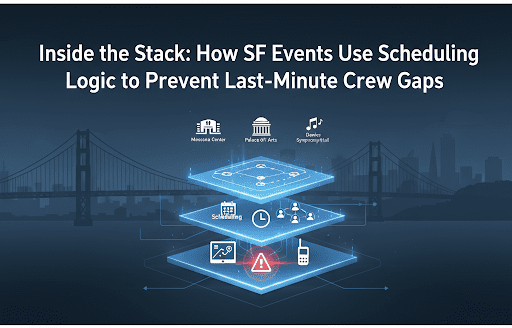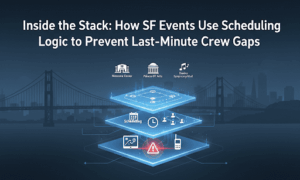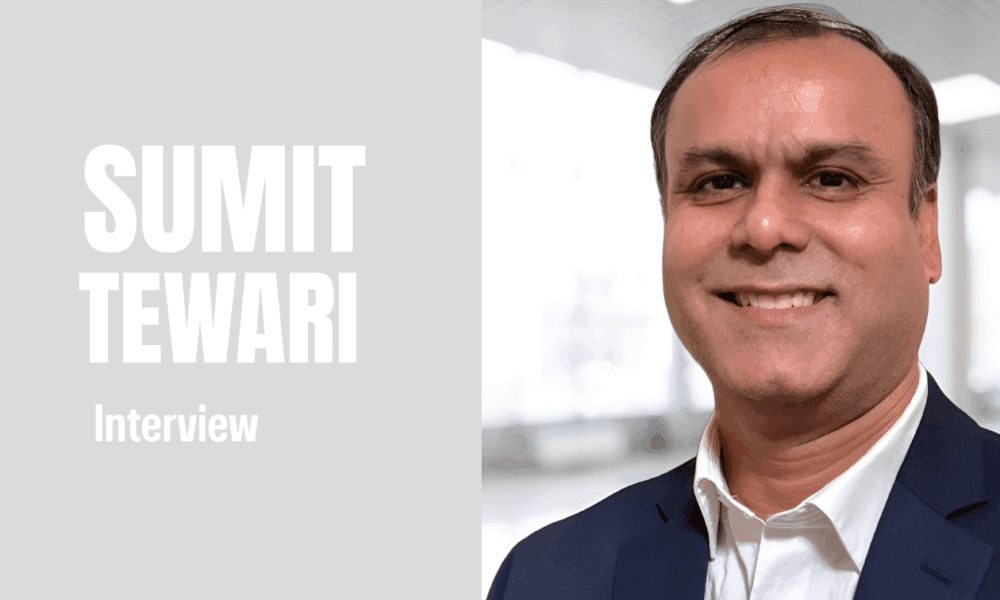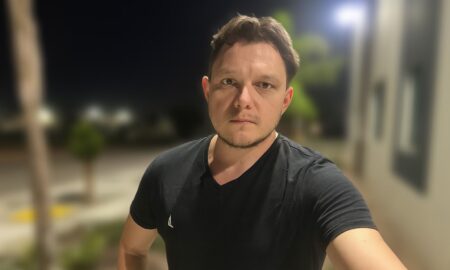San Francisco’s ecosystem of events runs on tight timelines and thin margins. Moscone Center books back-to-back conferences. SFMOMA hosts 400-person galas. The Ferry Building rotates pop-up activations. Yet unlike most industries, event staffing doesn’t tolerate last-minute substitutions—a missing AV tech or door coordinator compounds into cascading failures and reputational damage.
The operations teams managing these events learned years ago that crew gaps aren’t logistics problems. They’re scheduling problems. And scheduling problems have algorithmic solutions.
The SF Venue Constraint Reality
San Francisco’s geography creates hard constraints that don’t exist in most markets. Transit is fragmented. Moscone sits 15 minutes from BART. The Palace of Fine Arts is 20 minutes north. Davies Symphony Hall is Mission District. An event manager can’t assume a single freelancer covers two venues in a day—load-in windows close, parking is paid ($15–25/hour), and MUNI crowding during rush hours costs 30+ minutes.
Compound this with California’s labor regulations. AB 1522 requires meal breaks after 4 hours for shift workers. Venue access hours vary—some load in at 6 AM, others not until 10 AM. Weather adds friction: fog delays outdoor setup, heat means higher hydration/break requirements, and September wind events require equipment restraint protocols.
Inside operations teams at venues and event production companies, this complexity isn’t managed with Google Sheets. It’s modeled.
How Scheduling Solves Crew Availability
The math is straightforward but counterintuitive: events with the highest last-minute crew gaps are those with the most flexible shift requirements.
Consider a 12-hour conference day:
- Setup (5 AM–9 AM): 8 crew
- Morning sessions (9 AM–12 PM): 6 crew
- Lunch overlap (12 PM–1:30 PM): 4 crew
- Afternoon sessions (1:30 PM–5 PM): 6 crew
- Breakdown (5 PM–8 PM): 10 crew
Traditional hiring fills each block independently. This creates 34 crew-shift slots across five time blocks, each a separate contractor negotiation. One cancellation anywhere destabilizes the rest.
Advanced scheduling flips this. Instead, the system models continuous availability pools. A crew member booked for 8 AM start can fill either setup or morning sessions—but the system pre-flags which roles allow substitution (staging tech → A/V is acceptable; door coordinator → setup labor is not). This reduces theoretical positions from 34 to 18 core roles, then layers in 3–4 swing staff who can backfill any of the high-probability gaps.
The constraint becomes the input: geography, labor law, venue rules, and availability windows all feed a solver that outputs a crew roster that’s both lean and resilient.
The Input Stack
Behind this sits intake logic that most event planners don’t consciously model but intuitive operations teams use instinctively:
Venue and Load Moscone’s dock opens at 5:00 am and closes at 9:30 am (hard cut off, building security). The Palace of Fine Arts does not have a loading dock—equipment comes in through street-level access. Davies Symphony Hall requires union stagehands for any equipment on the main stage. Each has a staffing baseline: Moscone conference averages 1 crew per 50 attendees during sessions, 1 crew per 25 attendees during setup. Outdoor venues in September require 10% staff redundancy due to weather cancellations.
Availability Windows and Transit Time
The system knows geographic clusters. SoMa-based crew (likely) can reach Moscone in 8 minutes. Mission District crew needs 18 minutes to reach Davies. It’s not padding; it’s a limitation on who can cover a 9 AM start with backfill if someone cancels at 8:45 AM. Regulations:
California meal break law says if someone works beyond the 5 hour mark, they need a 30 minute break. It pays and conditions the shift system. For a conference from 9 AM to 5 PM, the best crew window is between 8 AM and 1 PM; any meal closer to the tail end of the second shift should be towards the latter part of lunch time.
Or they could come for 12 PM to 6 PM, in the afternoon hours. Splitting shifts across lunch saves one overlap crew member but creates two transition handoff points—higher risk.
Role Compatibility and Skill Depth
Not every role is interchangeable. A door coordinator manages access control and guest flow (judgment-heavy, client-facing). A setup tech moves equipment (lower skill variance). The system flags which roles have bench strength and which don’t.
If you have one certified SFFD compliance officer for a venue event, that person isn’t substitutable—but their 15-minute pre-event safety audit is scheduled first so cancellations don’t cascade from it.
How Operations Translate This Into Dispatch Logic
After the roster
Communication SLAs and Real-time Dispatch: Confirmation Windows Group Crewing is confirmed at 72 hours prior and re-confirmed 24 hours prior. This still captures 40–50% of scheduled cancellations outside cascades. The 24-hour re-confirm captures health/transport issues that emerged mid-week.
Rapid Substitution Protocol
If someone cancels within 24 hours, the system doesn’t start fresh. It queries the availability pool in geographic clusters. A Moscone event losing someone at 11 PM the night before doesn’t call 12 people randomly. It calls the 2–3 people in the Mission/SoMa cluster who flagged availability-on-demand for that role. Response window is 2 hours. Escalation to secondary pools (Oakland, Berkeley crews willing to transit) happens in parallel.
Role-Specific Dispatch Rules
AV tech cancellations trigger venue tech director notification (they may have backup in-house). Door coordinator cancellations trigger client host/venue manager (they can absorb flow for smaller events or brief internal staff). Setup labor cancellations are most flexible—can pull from same-day casual labor if needed (lower quality but acceptable for non-client-facing roles).
Live Shift Tracking
Modern operations use real-time check-in (SMS-based or app-based confirmation at arrival). If someone doesn’t check in within 15 minutes of start time, escalation triggers immediately—don’t wait for the shift to fail.
The KPI Dashboard
Operations teams monitoring this don’t use a single metric. They track:
- Coverage Rate: % of planned roles filled for an engagement (target: 98%+ across conferences, 95%+ for high-variance live events)
- Last-Minute Fill-Ins: % of scheduled roles backfilled on day-of (5%; regional aggregations over 8% merit further examination and player rotation)
- Geographic Response Time: Median time from cancellation alert to confirmed replacement (should be under 45 minutes; above 60 minutes means cluster redesign needed)
- Role-Specific Bench Strength: For each key role (AV, door, setup lead), how many qualified alternates are within 20 minutes? (Target: 2+ per role)
- Client Impact Events: # of client-facing issues caused by crew gaps (should be zero or near-zero; any occurrence triggers post-event audit)
These dashboards aren’t dashboards—they’re signals. When last-minute fill rate exceeds 8%, venues add a swing role. When geographic response time creeps past 60 minutes, they shift cluster boundaries or recruit in that zone.
A Moscone Case Study: Summer Conference Season
Moscone Center runs 15–20 three-day conferences annually. Each books 40–60 crew across 9 time blocks over three days. That’s 1,200–3,600 crew-shift slots annually.
One major tech conference series changed its intake process three years ago. Instead of booking crews by day and role independently, they modeled the entire three-day footprint as a single problem. This meant:
- Identifying the three highest-demand time blocks (usually setup day 1, full-load days 2–3)
- Booking deep bench in the two roles most likely to cancel (setup labor and door coordinators typically run 30–40% cancellation in SF during summer)
- Locking in role-compatible cross-training (two setup leads who could also run door if needed)
- Pre-negotiating Tuesday-Friday availability slots with crews (avoiding Monday, which runs 60% higher cancellation in SF due to weekend recovery)
Result: over 36 months, their client-facing crew gap incidents dropped from 2–3 per conference to zero. More operationally, their last-minute hiring dropped 60%. Labor costs actually fell because they weren’t paying premium rates for same-day backfill.
The Playbook: Building Resilient Crew Scheduling
Intake Phase:
- Map venue constraints (load windows, access rules, union requirements, capacity norms)
- Define role compatibility layers (which roles can substitute in emergency; which are critical-path only)
- Cluster crew geographically around your target venue or event portfolio (if you run multiple SF venues, map 3–4 geographic clusters)
- Build bench depth: for any role exceeding 30% cancellation historically, maintain 2 qualified backups per primary
Roster Phase:
- Confirm 72 hours out and 24 hours out
- Embed role-specific SLAs in confirmation (e.g., AV tech must confirm by 3 PM the day before)
- Flag high-volatility time blocks (anything before 8 AM or after 6 PM runs 20–30% higher cancellation in SF)
Dispatch and Real-Time:
- Set escalation triggers (cancellation = 2-hour response window to confirm backfill)
- Use geographic proximity as primary substitution logic
- Embed client/venue notification loops so no surprises at gate time
- Lock in check-in confirmation (arrival within 15 minutes or immediate escalation)
Post-Event Audit:
- Track which roles saw backfill; if any role exceeded 8% substitution, revisit bench depth
- Identify geographic or time-based clusters that underperformed; shift recruitment or routing
- Calculate true cost of crew variability (cancellations + backfill premium + client impact) to justify operational investment
Why This Matters Beyond Logistics
For San Francisco event operations, crew scheduling optimization isn’t about cutting labor costs. It’s about eliminating operational friction so coordinators and venue managers can focus on guest experience instead of crisis management at 8 AM load-in.
Every well-run event depends on predictable crew reliability. The venues and production companies that compete for marquee events in San Francisco aren’t the cheapest. They’re the most operationally reliable. And operational reliability runs on scheduling systems, not spreadsheets.
The playbook isn’t complicated. But it requires treating crew availability as a system problem—one with inputs, constraints, and outputs that can be modeled and improved.
For large events in San Francisco, this approach has become table stakes. The production companies managing complex multi-day activations across San Francisco event staffing venues aren’t improvising crew rosters 48 hours before the event. They’re building resilient systems that absorb the inevitable friction SF’s geography and regulations create.
That system-first thinking is the difference between an event that runs and an event that runs flawlessly.





























